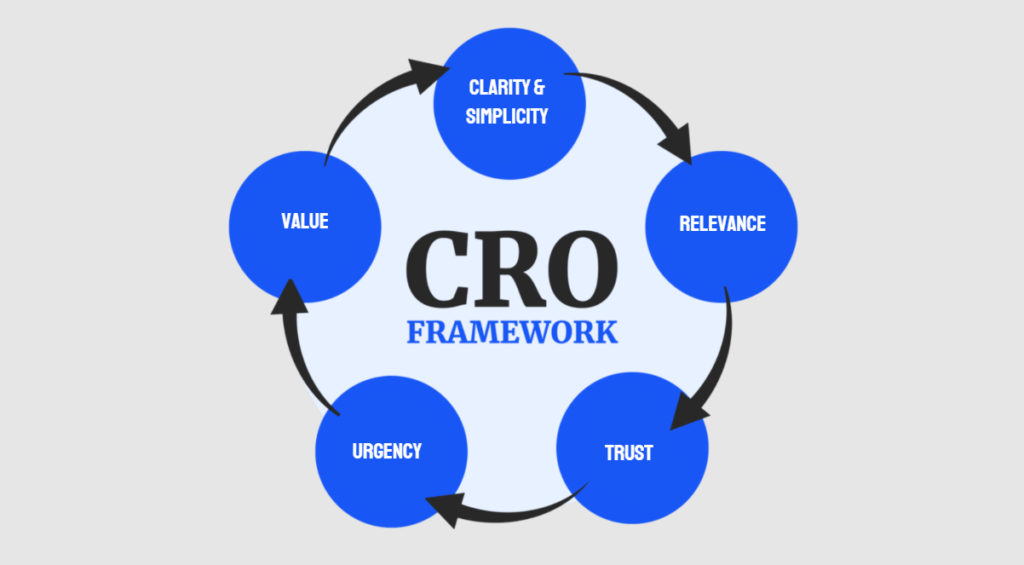In the digital marketing landscape, converting visitors into customers or leads is paramount. However, achieving a high conversion rate requires more than just guesswork; it demands a strategic and analytical approach. CRO heuristics provide a framework for systematically evaluating and improving various aspects of a website or campaign to enhance its effectiveness in driving conversions. This guide explores the foundational principles of CRO heuristics and how they can be applied to streamline the optimisation process.
The Importance of CRO Heuristics
CRO heuristics play a crucial role in identifying barriers to conversion and uncovering opportunities for improvement. These principles, grounded in behavioral psychology and user experience design, provide a systematic framework for evaluating and enhancing the effectiveness of digital touchpoints. Let’s delve into key CRO heuristics and their significance:
1. Clarity
Can I understand what the product/service is, and how it works (in a reasonable amount of time)?
The message, value proposition, and call-to-action (CTA) on a website must be clear and unmistakable. Users should immediately understand what is being offered and why it is valuable to them. Clarity in messaging ensures that visitors are not confused or overwhelmed, making them more likely to convert.
2. Simplicity
Frictions: Defined as a psychological resistance to a given element in the sales or sign-up process.
Websites and landing pages should be designed with simplicity in mind, focusing on essential elements and removing unnecessary distractions. A simple and intuitive design facilitates a smoother user journey, reducing friction and encouraging conversions.
3. Relevance
Are we offering web content that matches what the ad promises?
Content and offers must be relevant to the target audience’s needs, interests, and stage in the buyer’s journey. Tailoring the user experience to match audience expectations increases engagement and the likelihood of conversion.
4. Urgency
What incentives do we have for them to convert? is the offer clear enough to turn motivation into conversion
Creating a sense of urgency can encourage users to take action promptly. This can be achieved through limited-time offers, countdown timers, or highlighting the scarcity of a product or service. Urgency should be used judiciously to avoid appearing manipulative.
5. Trust
Trust elements that can be found on the landing page
Building trust is essential for conversion. This can be accomplished through the use of trust signals such as testimonials, reviews, security badges, and clear privacy policies. Establishing credibility reassures users and reduces perceived risk.
6. Value
What should we be asking cold, warm and hot traffic to do on each landing page?
Users must perceive that the value of what they are receiving outweighs the cost (monetary or otherwise) of taking action. Highlighting the benefits and unique selling points of a product or service can enhance perceived value and motivate conversions.
Applying CRO Heuristics: A Step-by-Step Approach
- Audit and Analysis: Begin with a comprehensive audit of your website or landing page, evaluating it against CRO heuristic principles. Identify areas that lack clarity, simplicity, relevance, urgency, trust, or value.
- Prioritise Improvements: Based on the audit, prioritise changes that are likely to have the most significant impact on conversion rates. Consider both quick wins and longer-term strategic adjustments.
- Implement Changes: Make the identified improvements, ensuring that each change aligns with the heuristic principles. This might involve redesigning elements, rewriting copy, or rethinking the user flow.
- Test and Refine: Use A/B testing or multivariate testing to evaluate the effectiveness of changes. Analyse the results to understand what works and why, then refine your approach based on data-driven insights.
- Repeat the Process: CRO is an ongoing process. Continuously apply CRO heuristics to new and existing pages, learning from each iteration to gradually enhance the user experience and conversion rates.

CRO heuristics provide a structured and systematic approach to optimising digital experiences for better conversion rates. By applying these principles, businesses can create more engaging, intuitive, and persuasive websites and campaigns that resonate with their target audience. While the process requires ongoing effort and iteration, the rewards in terms of improved conversions and customer satisfaction are significant. As the digital landscape evolves, so too will the application of CRO heuristics, offering continuous opportunities for growth and optimisation.


